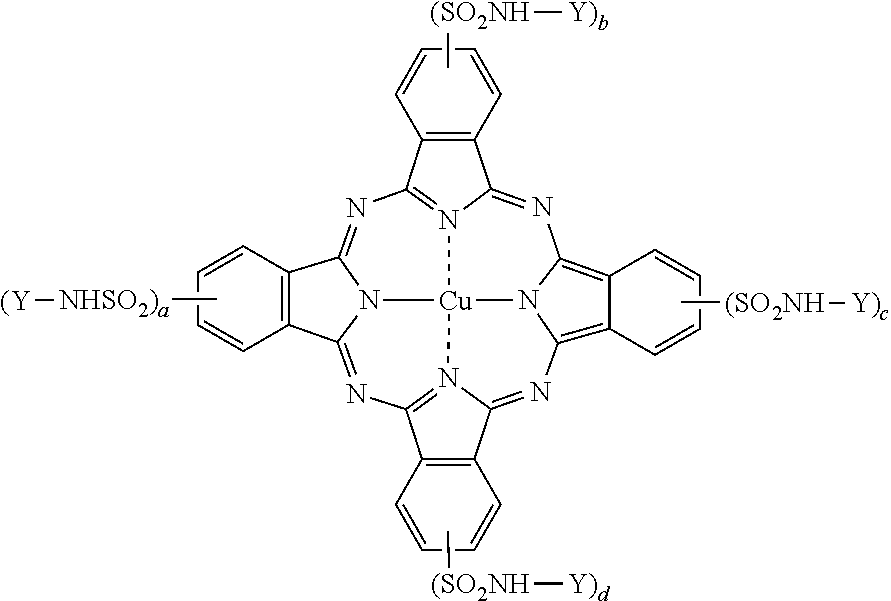Carbon nanotube dispersions
a technology of carbon nanotubes and dispersions, applied in the field of carbon nanotube dispersions, can solve the problems of reducing the aggregation behavior of carbon nanotubes
- Summary
- Abstract
- Description
- Claims
- Application Information
AI Technical Summary
Problems solved by technology
Method used
Image
Examples
example 1
[0075]Dispersant A was prepared by charging a presscake containing 210 parts by weight of copper phthalocyanine sulfonyl chloride (which may be made by any conventional method) into a mixture of 692 parts by weight of a primary amine-terminated poly(ethylene oxide / propylene oxide) (6 / 29) copolymer having a number average molecular weight of approximately 2000 (available as Jeffamine M-2005 from Huntsman Corporation) and 66 parts by weight of sodium carbonate and mixed. The final reaction mixture was then heated to 80-90 C under vacuum to remove water to produce dispersant A.
[0076]To a 20 mL scintavial were added 10.0 mg of NanoBlack II (MWCNTs, Columbian Chemical Corp.) and 4.0 mg of Dispersant A in 15 mL of ethyl acetate. The mixture was allowed to stand for 1 h to allow Dispersant A to dissolve in the ethyl acetate resulting in a deep blue solution with the black particles of NanoBlack II present at the bottom of the vial. The scintvial was then placed in a Branson 2510 bath sonic...
example 2
[0077]To a 20 mL scintivial were added 10.0 mg of NanoBlack II (MWCNTs) and only 2.5 mg of Dispersant A in 15 mL of ethyl acetate. The mixture was allowed to stand for 1 h to allow Dispersant A to dissolve in the ethyl acetate resulting in a deep blue solution with the black particles of NanoBlack II present at the bottom of the vial. The scintivial was then placed in a Branson 2510 bath sonicator and sonicated at maximum power for 90 min. After 90 min., the sonication bath water was replaced with tap water and sonication repeated for a second 90 min interval. After standing for 1 h, the scintivial solution was clear except for black sediment at the bottom. The absence of the deep blue color from Dispersant A in the scintivial after sonication and centrifugation is consistent with strong absorption of Dispersant A on to the NanoBlack II but at an amount below that necessary to disperse NanoBlack II in ethyl acetate.
example 4
[0079]To a 20 mL scintavial were added 4.3 mg of Elicarb MWCNTs (Thomas Swan & Co.) and 2.1 mg of Dispersant A in 15 mL of ethyl acetate. The mixture was allowed to stand for 1 h to allow Dispersant A to dissolve in the ethyl acetate resulting in a deep blue solution with the black particles of Elicarb MWCNTs present at the bottom of the vial. The scintivial was then placed in a Branson 2510 bath sonicator and sonicated at maximum power for 90 min. After 90 min, the sonication bath water was replaced with tap water and sonication repeated for a second 90 min interval. The resulting dark black solution was centrifuged at 10,000 RPM for 30 min on a K Prima-15R centrifuge (Composite Rotor, Inc.). The dispersion remained black in color with a small amount of sediment present in the bottom of the centrifuge tube. The presence of dispersed CNTs in the ethyl acetate was confirmed by scanning electron microscopy of a dried sample of the supernatant. The presence of Dispersant A absorbed on ...
PUM
| Property | Measurement | Unit |
|---|---|---|
| Molar mass | aaaaa | aaaaa |
| Molar mass | aaaaa | aaaaa |
| Composition | aaaaa | aaaaa |
Abstract
Description
Claims
Application Information
 Login to View More
Login to View More - R&D
- Intellectual Property
- Life Sciences
- Materials
- Tech Scout
- Unparalleled Data Quality
- Higher Quality Content
- 60% Fewer Hallucinations
Browse by: Latest US Patents, China's latest patents, Technical Efficacy Thesaurus, Application Domain, Technology Topic, Popular Technical Reports.
© 2025 PatSnap. All rights reserved.Legal|Privacy policy|Modern Slavery Act Transparency Statement|Sitemap|About US| Contact US: help@patsnap.com


